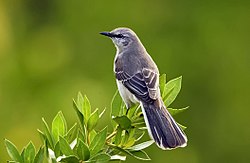| Mockingbird | |
|---|---|
 | |
| Northern mockingbird Mimus polyglottos | |
| Scientific classification | |
| Domain: | Eukaryota |
| Kingdom: | Animalia |
| Phylum: | Chordata |
| Class: | Aves |
| Order: | Passeriformes |
| Superfamily: | Muscicapoidea |
| Family: | Mimidae |
| Genera | |
Mockingbirds are a group of New World passerine birds from the family Mimidae. They are best known for the habit of some species mimicking the songs of other birds and the sounds of insects and amphibians, [1] often loudly and in rapid succession and for being extremely territorial when raising hatchlings. Studies have shown the ability of some species to identify individual humans and treat them differently based on learned threat assessments. [2]
Contents
The only mockingbird commonly found in North America is the northern mockingbird. Mockingbirds are known for singing late at night, even past midnight. [3]
They are opportunistic omnivores, feeding on insects, fruits, seeds, and occasional greens. [4]
The northern mockingbird is the state bird of five states in the United States, a trend that was started in 1920, when the Texas Federation of Women's Clubs proposed the idea. In January 1927, Governor Dan Moody approved this, and Texas became the first state ever to choose a state bird. Since then, Arkansas, Florida, Mississippi, and Tennessee have also adopted the northern mockingbird as their official state bird. [5]

